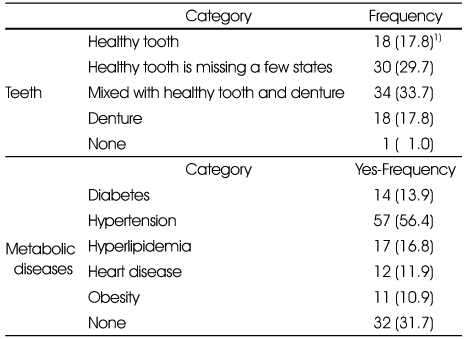References
1. Bettman JR, Whan Park C. Effects of prior knowledge and experience and phase of the choice process on consumer decision process, A protocol analysis. J Consumer Res 1980. 7(3)234–248.
2. Bok HJ, Choi SK. A study of possibilities on developing of traditional convenience foods for anti-aging control an analysis of public perspectives. J East Asian Soc Diet Life 2008. 18(3)322–330.
3. Cho SH. Food science 2008. Paju: Kyomunsa; 342–343.
4. Chung LN, Lee HY, Yang IS. The structural correlation between consumer's attitudes and intention of repurchase of Home Meal Replacement (HMR) according to the product categories. Korean J Community Nutr 2007. 12(3)344–351.
5. De BM, McCarthy M, Cowan C, Ryan I. The influence of lifestyle characteristics and beliefs about convenience food on the demand for convenience foods in the Irish market. Food Quality & Preference 2004. 15(2)155–165.
6. Hur MR. The chemosensory changes and nutritional status in Korean elderly woman 1999. Ewha Womans University; MS thesis.
7. Jung RN, Lee HY, Yang IS. What's the consideration attribute on purchasing the HMR? Korean J Food Cult 2007. 22(3)315–322.
8. Jung JH. A study on co-relationship customer behavior and selection attributes in the food-court 2002. Sejong University; MS thesis.
9. Kang MS. A study of yaksunyori menu develop a plan 2002. Hanyang University; MS thesis.
10. Korean National Statistical Office. Estimated future population 2010-2060 2011. cited 2011 December 7. Available from
http://www.kostat.go.kr.
11. Kim HY, Choi SH, Ju SE. A survey of the behaviors on fast food restaurants. J Korean Soc Diet Cult 1996. 11(1)71–82.
12. Kim HY, Ryu SH. Evaluation of hazardous factors for the application of HACCP on production and transportation flow in home-delivered meals for the elderly. Korean J Soc Food Cookery Sci 2003a. 19(2)195–209.
13. Kim HY, Ryu SH. Changes of chemical and microbiological quality of home-delivered meals for elderly as affected by packaging methods and storage conditions 2. Korean J Soc Food Cookery Sci 2003b. 19(2)241–253.
14. Kim HY, Ryu SH. Changes of physical and sensory quality in home-delivered meals for elderly as affected by packaging methods and storage conditions 3. Korean J Soc Food Cookery Sci 2003c. 19(3)374–389.
15. Kim IS, YU HH, Kim YS. A study on nutrient intake, food behavior and health conditions according to food intake diversity in the elderly in a local city. Korean J Community Nutr 2001. 2(6)205–217.
16. Kim MH, Han JS, Lee HS. A study on image and consumption about instant food of urban homemaker. J Korean Home Econ Assoc 1988. 26(3)69–78.
17. Kim TH, Seo Eun. Effect of the elderly consumers' education level on eating-out decision making process. Korean J Food Cult 2005. 20(6)638–643.
18. Labrecque J, Ricard L. Children's influence on family decision-making: a restaurant study. J Bus Res 2001. 54(2)173–176.
19. Lee HK, Kim JW. Fostering the private sector in humanservice market. Gyeonggi Research Institute 1998.
20. Lee HY, Jung RN, Yang IS. Consumer inclination to convenience toward home meal replacement. J Foodserv Manage 2007. 10(2)285–315.
21. Lee KY. A study on the commodity substitution of housework in Korea 1987. Seoul National University; Ph.D Thesis.
22. Park EM, Kim YS. A study on the behavior related to brassieres purchasing decision making of elderly women. J Korean Home Econ Assoc 1997. 35(2)65–79.
23. Park SJ, Lee HJ, Choi HM. Evaluation of menus using antioxidant-rich foods at a congregate meal program for the Korean elderly. Korean J Community Nutr 2006. 11(6)761–770.
24. Schiffman Leon G. Sources of information for the elderly. J Advertising Res 1971. 1033–37.
25. Seo BC, Kim SE. Analysis of purchasing behaviors for Korean elderly consumers. Korean J Food Mark Econ 2005. 10(4)23–39.
26. Won HS. Effect of age-related changes in taste perception on nutritional status and validation of food frequecy questionnaire for the Korean elderly 1997. Ewha womans University; MS thesis.
27. Won YH. Silver marketing 2008. Seoul: Daehaksulim; 23–24.
28. Yang SA. A study on the plan of public space in inner city senior tower for active seniors 2008. Hongik University; MS thesis.









